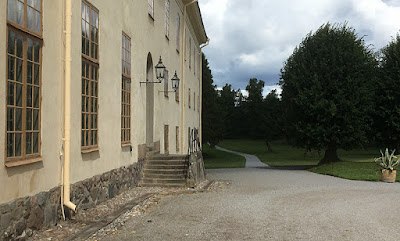Swedish title: Syskonbädd 1782
dir. Vilgot Sjöman
It’s a free adaptation of John Ford’s 17th century play ’Tis Pity She’s a Whore (also filmed by Guiseppe Patroni Griffi as Addio fratello crudele in 1971.) The director Sjöman transposed the action to 18th century Sweden, and the film was shot in and around Stockholm using authentic period locations.
The estate where young nobleman Jacob (Per Oscarsson) carries on an illicit affair with his sister Charlotte (Bibi Andersson) – Sturehov Manor, 145 90 Norsborg, Sweden. The estate got its name from the Sture family who owned it in the 16th and 17th centuries. In the following decades, the property changed hands a few times, and in 1778 it was acquired by Johan Liljencrantz, a finance minister in King Gustav III's court. Liljencrantz hired architect Carl Fredrik Adelcrantz to design a new manor building and gardens. The main building was completed sometime in 1781. After the death of Liljencrantz the estate was sold again, and changed owners a few times until it was purchased by Stockholm Municipality in 1899. After suffering from neglect throughout most of the 19th and early 20th centuries, the manor underwent an extensive renovation in 1954–59 in which the 18th century interiors were restored. The visitors can take a tour of the manor and have a lunch in the period setting.
The church – Östra Ryd Church, Östra Ryds Kyrkväg 21, Åkersberga, Sweden.
Charlotte sees a thief apprehended in the street – Mäster Mikaels gata, Stockholm, Sweden.
Charlotte goes to her dressmaker – Rutenbeckska gården, between Katarina östra kyrkogårdsgränd, Mäster Mikaels gata and Nytorgsgatan, Stockholm, Sweden. The church seen behind it is the Katarina church in Södermalm. The courtyard was renovated in the 1970s, and isn’t open to non-residents.
The archival photo shows how it looked before the renovation.
Karl Ulrik Alsmeden (Jarl Kulle) has an audience with the king – Drottningholm Palace, Drottningholms Slott Slottsstallet 11, Drottningholm, Sweden. The palace is the residence of the King and Queen of Sweden. The rooms in the southern wing of the palace are reserved for the royal family. Though most of the palace and grounds are open to the public, the area adjacent to the northern façade is fenced, and it’s impossible to come closer to take a picture.
Karl Ulrik attends Jacob’s rehearsal – Drottningholm Theatre, Drottningholm, Sweden. It is one of the few 18th century theatres in Europe that hosts stage performances in an authentic period setting and using its original stage machinery. The exterior of the theatre was also used in The Magic Flute (1975) directed by Ingmar Bergman but the interiors were meticulously recreated in a studio.
Count Schwartz’s (Gunnar Björnstrand) funeral – Still searching for this location.
Ebba (Tina Hedström) grabs a pistol from the armory – Skokloster Castle, Skokloster, Sweden. The castle was built in 1654–1676 for Count Carl Gustaf Wrangel, one of the country’s most prominent military men, and his wife Anna Margareta von Haugwitz. None of their sons lived long enough to start a family. Their oldest daughter Juliana Wrangel and her husband Nils Brahe the Younger took over the castle in 1676. Skokloster remained in Brahe family ownership until the line died out in 1930 and it passed to the von Essen family. In 1967, the Von Essens sold the castle and its collections to the Swedish government who turned it into a state museum. It’s considered one of the best preserved baroque castles in Europe. The castle armory holds the largest collection of 17th century weapons in the world: muskets, pistols, and swords, including Japanese samurai swords. It also has armor, pikes and crossbows. They may have rearranged the objects for the filming because the swords and the suit of armor seen in the movie are actually in a different room. It’s also possible that they were moved around when the castle had become a museum.








































No comments:
Post a Comment